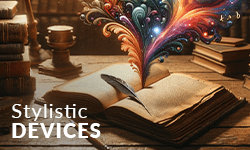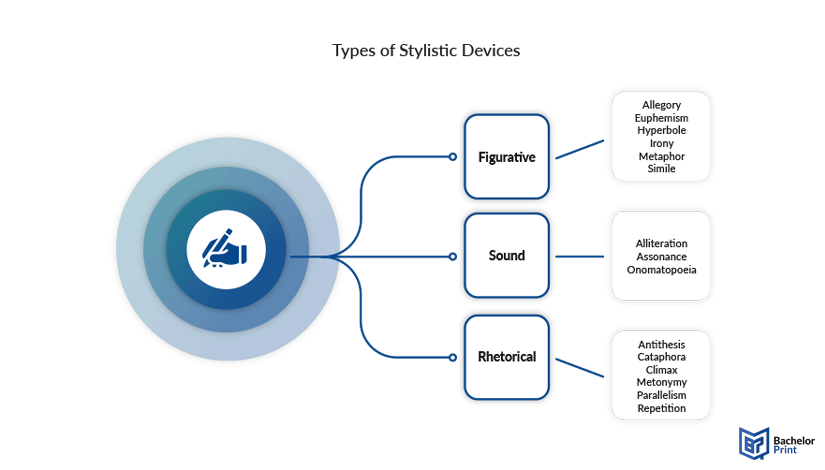
Writing is a form of communication that we cannot live without, whether in business or at home. Stylistic devices are linguistic tools used by writers to enhance the appeal of their writing style, add layers of meaning, and engage readers by altering language in creative and artistic ways. In this article, you’ll find out everything there is to know about these stylistic devices.
Definition: Stylistic devices
Stylistic devices are typically considered figures of speech, whose key aspect is departing from straightforward or literal language to create depth, emphasize ideas, or convey emotions in a more vivid and imaginative way. These aspects are the factors behind their widespread use in various creative fields, such as academic essays, literature, poetry, speeches, and advertising. In academic writing, they are often used more subtly compared to literary writing.
Stylistic devices encompass a wide range of techniques, such as irony, simile, metaphor, and many others, each serving to achieve specific rhetorical or aesthetic objectives. The variety and complexity of language is enhanced by stylistic devices, enabling writers to convey concepts, express feelings, and shape perceptions with greater clarity and resonance.
in Your Thesis
Stylistic devices: Functions
Stylistic devices serve several functions in writing and speech. Below, you will find the most significant ones, along with their respective examples.
Enhancing clarity
Stylistic devices can help writers convey complex ideas more clearly and effectively by using vivid imagery, comparisons, and other techniques to make abstract concepts more concrete.
Creating emphasis
Stylistic devices draw attention to key points, or emotions in a text, which helps emphasize their importance and impact on the reader.
Vivid imagery
Through the use of descriptive language, metaphors, similes, and other stylistic devices, writers can paint vivid mental pictures in the reader’s mind, enhancing the imagery and sensory experience of the writing.
Adding depth
Figures of speech enhance the quality of writing by adding depth and texture to writing, making it more nuanced and multidimensional by layering different elements of language and meaning.
Types of stylistic devices
Stylistic devices can have different categories, e.g., focusing on the sound of words. In this paragraph, we will differentiate between various stylistic tools and give examples for each of them.
Figurative devices are techniques used by writers and speakers to convey meaning beyond the literal interpretation of words. These types of stylistic devices add depth and imagery to language, making it more expressive and engaging. Common figurative devices include metaphors, similes, personification, hyperbole, and irony, among others. Each device will be explained below, together with examples.
Metaphor & Simile
By contrasting an item or person with another, prolific writers aid individuals in perceiving the subject from a unique perspective. The sole distinction between a metaphor and a simile is that a metaphor does not draw attention to the fact that it is a comparison, whereas a simile uses one of the comparing terms “like” or “as,” making it easy to recognise.
Personification
Giving human characteristics to non-human entities can make writing come to life. As a result, personification helps the writer express what actual human characters feel by connecting those emotions to their natural world.
Irony
Irony can be categorized as either dramatic, verbal, or situational. Verbal irony uses words to express something that contrasts from their literal meaning, while dramatic irony is where the situation is understandable by the audience, but the fictional character is not aware, creating suspense. Situational irony, occurs when there is a discrepancy between what is expected to happen and what actually happens, involving a twist in the story.
Hyperbole
A writer who uses hyperbole is using an exaggeration, that is not supposed to be taken literally, but emphasizes the statement. The opposite of hyperbole is litotes, which is an understatement.
Euphemism
Euphemism is a device where a milder or less direct word or phrase is used in place of one that is considered harsh or unpleasant, softening the impact. The opposite is dysphemism, which uses a harsh or offensive term for a more neutral or polite one.
Allusion
The stylistic device allusion refers to a brief and indirect reference to a well-known person, place, event, or another literary work. Allusions are often used in poetry, to add symbolic imagery, or invite readers to engage actively with the poem.
Allegory
Allegory is the use of characters and events to represent ideas. A writer can use this stylistic device to convey hidden meanings, typically moral or political, through symbolic actions, figures, and imagery.
In the realm of writing, authors employ sound devices as a means of generating auditory effects and rhythm in their work, thereby elevating the text’s remembrance. These types of stylistic devices are especially prominent in poetry, since they play with the sound of words and phrases to evoke specific emotions or enhance the reader’s experience.
Some common sound devices include alliteration, assonance, and onomatopoeia. Each tool will be explained below, together with examples.
Alliteration
Alliteration refers to the use of the same first consonant in a series of words. It can also be the repetition of a single sound at the beginning of several words that follow each other in a sentence. It emphasizes the repeated words and creates a rhythm that makes a piece of text more pleasant to listen to or read.
Assonance
Assonance is the repetition of vowel sounds in a sentence. The use of this stylistic device gives writing rhythm and sound, which may influence the reader’s mood.
Onomatopoeia
Onomatopoeia is a sonic device, where words imitate the natural sounds of things they describe. This stylistic device is commonly used in poetry, prose, and other forms of writing.
Rhetorical devices are used to persuade the audience or enhance the rhetorical impact of the text. These tools are focused on the structure and delivery of the message, rather than the content itself. Oftentimes, the meanings of both figurative and rhetorical devices overlap, yet the former specifically conveys a true meaning beyond the literal interpretation.
Parallelism
Parallelism is a rhetorical device, in which a writer or speaker uses similar grammatical structures to create balance and emphasis in their writing. It is commonly used in literature, speeches, and other forms of persuasive writing to enhance clarity and impact.
Repetition
Repetition can be a powerful tool for prolific writers and speakers to create impact and engage their audience. It helps reinforce the central theme or message of a piece of writing, and make it more memorable to the reader or listener.
While it can certainly contribute to the rhythm of a piece of writing or speech, its primary function is to create emphasis through the repetition of words or phrases. Repetition is an umbrella term for devices, such as epistrophe, anadiplosis, anaphora, chiasmus, and others.
Cataphora
The rhetorical device cataphora is the use of a pronoun or other linguistic unit in an earlier phrase to refer ahead to another word or phrase within a sentence or discourse.
Climax
You achieve the rhetorical device climax by arranging words in an order of gradually increasing importance or tension. The opposite of climax is anticlimax, where tension descends as the text progresses.
Antithesis
An antithesis is the juxtaposition of contrasting words or phrases within a parallel grammatical structure, often used to emphasize contrast, or highlight a point. It’s commonly used in literature, speeches, and debates to underscore a theme or argument by presenting its opposite in a structured and impactful way.
Metonymy
Metonymy refers to a figure of speech in which one word or phrase is substituted for another with which it is closely associated.

Impact on literature
As mentioned in the examples above, stylistic devices have a significant impact on different genres of literature, influencing the tone of non-fiction and fiction writing. In this paragraph, we’ll break down the effects of their use in various genres, as well as the most popular stylistic devices.
Fiction
In fiction, stylistic devices are used to develop characters, create vivid setting, and advance the plot. Devices such as imagery, metaphor, and simile can transport readers to imaginary worlds and evoke strong emotional responses from readers.
Dialogue and characterization benefit from techniques like repetition and irony, which add depth and complexity to the shop. Flashbacks, foreshadowing, and other structural literary devices enhance narrative flow and engage readers’ interest.
Poetry
Stylistic devices are integral to poetry, where they shape the rhythm and sound patterns of the verse. Incorporation of devices such as rhyme, alliteration, anaphora, and assonance create musicality and enhance the aesthetic appeal of the poem.
Imagery through metaphors and personification evokes powerful sensory experiences and conveys abstract concepts in a condensed form. Poetic devices like parallelism contribute to the poem’s structure and enhance its thematic resonance.
Plays & speeches
Like other forms of literature, plays are crafted with careful attention to language, characterization, plot, and themes. Plays often explore complex human experiences and societal issues, making them an important form of literary expression. Playwrights may use certain motifs or symbols in repetition throughout the play to underscore key themes. A most common tool is dramatic irony, which leads to tension and suspense.
Similarly, speeches are written or spoken compositions, often intended to persuade audiences. Famous speeches, such as Martin Luther King Jr.’s “I Have a Dream” speech or Abraham Lincoln’s “Gettysburg Address,” are frequently studied for their rhetorical techniques. Generally, rhetorical questions are used to engage the audience and encourage active listening. A common stylistic device is repetition, which enhances memorability.
Tips to elevate your writing
To round off this article, here’s a list of helpful tips on how you can improve your writing style and its quality.
- Study examples: Read widely across different genres and pay attention to how authors use stylistic devices to enhance their writing. Analyze the impact of them on tone, mood, and overall effectiveness.
- Practice regularly: Experiment with incorporating stylistic devices into your writing regularly. Start with simple exercises and gradually work your way up to more complex techniques.
- Consider context: Choose tools that are appropriate for the genre and audience of your writing. Consider how the devices will resonate with your readers and support your intended message.
- Balance creativity with clarity: While they may add flair, avoid overloading your text with too many devices. Strive for a balance between stylistic richness and clarity of expression.
- Embrace experimentation: Don’t be afraid to experiment with new stylistic devices or unconventional approaches to writing. Push yourself out of your comfort zone and explore different ways of expression.
- Keep learning: Continuously seek opportunities to expand your knowledge and skills. Attend writing workshops, read craft books, and engage with writing communities to deepen your understanding and hone your skills. Practice makes perfect.
- ✓ Free express delivery
- ✓ Individual embossing
- ✓ Selection of high-quality bindings
FAQs
Stylistic devices are techniques used by prolific writers to enhance their writing and create specific effects. Examples include metaphors, similes, irony, and personification.
Stylistic devices are important in both writing and speech since they add uniqueness to your text by providing clarity, emphasis, and freshness of expression. Reading a text with well-placed stylistic devices is more interesting than reading plain text. Learning how to apply different stylistic devices in your writing will help you elevate your writing from plain text to addictive pieces of art.
While these words are used interchangeably, stylistic devices are tricks that make written material enjoyable to read. In contrast, literary devices are tools that create an effect that deepens the reader’s understanding of the issue or insight that the writer is delivering.
Figurative language is a subset of stylistic devices. It specifically refers to language that uses figures of speech to convey meanings beyond the literal interpretations of words. Stylistic devices encompass a broader range of techniques used by writers to enhance their writing process, including both literal and figurative elements.
